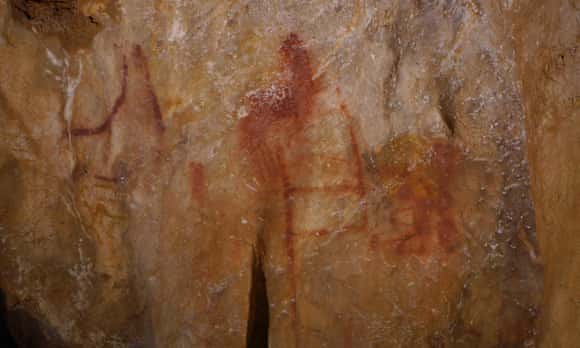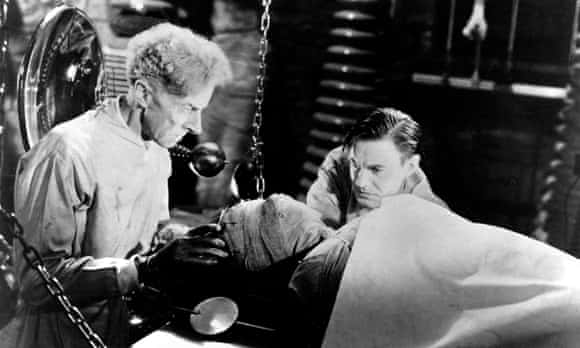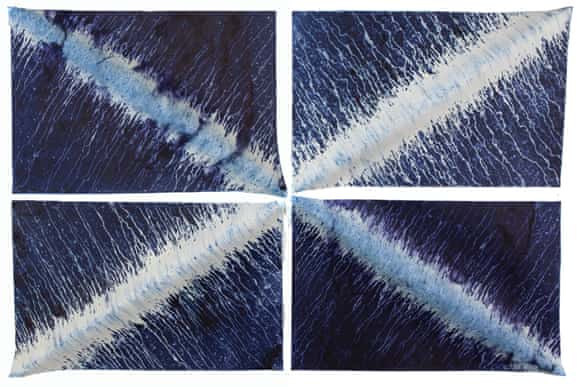 | Lab notes: meet the primitive Picassos – our arty ancestors the Neanderthals |  |  Neanderthal paintings in the La Pasiega cave, Spain. Not so Homo stupidus now, eh? In your face, haters/early evolutionists. Photograph: Handout/Reuters
| Tash Reith-Banks
| This week's biggest stories This weeks headlines have been full of our ancestors, most prominently the discovery that Neanderthals painted on cave walls in Spain 65,000 years ago – tens of thousands of years before the arrival of modern humans. Some say this made them the first artists on Earth, but Guardian art critic Jonathan Jones has some interesting points to make about that claim. Neanderthals aside, an intriguing theory that Homo erectus may have been a sailor and able to speak has been put forward. Researchers also say that ancient DNA reveals that the arrival of the Beaker folk changed Britain forever. Genetic analysis has shown that at least 90% of the ancestry of Britons was replaced by a wave of migrants, who arrived about 4,500 years ago. Also unpicking the past were some Australian scientists, who say that if you want to know about T rex's locomotion then watching how an ibis moves might just be the key. Another team of antipodean researchers are using 3D scans to try to unlock the evolutionary history of the Tasmanian tiger. Shedding light in a totally different way were scientists who have used synthetic bioluminescent molecules to make brain cells glow so brightly they can be seen outside the body. Used only in animals so far, the luminescence allows researchers to track individual cells in animals with unprecedented accuracy. The future's bright, it seems ... More news from Guardian Science | Sign up to Lab notes
___ Archaeological controversy |  |  Clovis points from the Rummells-Maske Site. Photograph: Billwhittaker at English Wikipedia via Wikimedia Commons
| Last month's release of The Ice Bridge, an episode in the Canadian Broadcasting Corporation series The Nature of Things has once again revived public discussion of a controversial idea about how the Americas were peopled known as the "Solutrean hypothesis". This idea suggests a European origin for the peoples who made the Clovis tools, the first recognized stone tool tradition in the Americas. One of the experts appearing on the documentary was Jennifer Raff, who writes for our blog The Past and The Curious and is a geneticist who specialises in the study of human variation among contemporary and ancient populations. She shares her thoughts about it – and why she see the ideas portrayed within the documentary as unsettling, unwise, and scientifically implausible. ___ Straight from the lab – top picks from our experts on the blog network |  |  Looking at the nuts and bolts of creature creation. Photograph: Ronald Grant Archive
| How to make a monster: what's the science behind Shelley's Frankenstein? | Notes & Theories In terms of the technical aspects of building a creature from scraps, many people focus on the collecting of the raw materials and reanimation stages. It's understandable as there are many great stories about grave-robbers and dissection rooms as well as electrical experiments that were performed on recently executed murderers. But there quite a few stages between digging up dead bodies and reanimating a creature. The months of tedious and fiddly surgery to bring everything together are often glossed over, but what virtually no one mentions is how difficult it would have been to keep the bits and pieces in a suitable state of preservation while Victor worked on his creation. Making a monster takes time, and bodies rot very quickly. The new specimen forcing a radical rethink of Archaeopteryx | Lost Worlds Revisited The new specimen represents a largely intact skeleton lying on its left side. The stone slab it is preserved in was found in a number of pieces, resulting in some bone loss along the vertebral column. No feathers are preserved. The skull has been dislocated from the body and rotated downwards and back, giving the specimen a characteristic look that is very different from the classical death pose with the head and neck arching backwards towards the tail. The stone slab also contains a beautiful ammonite, for those who prefer their fossils spineless. How much mass does the W boson have? | Life and Physics The mass of the W boson is a key parameter of the Standard Model of particle physics, the framework we use to describe all the fundamental forces and particles1. The mass itself comes from the Brout-Englert-Higgs mechanism, as does the mass of all fundamental particles in the Standard Model. But the W is more intimately intertwined than most with the Higgs boson, the last and crucial particle of the Standard Model discovered in 2012. Because of this, precise measurements of the W mass have a powerful influence on the possible ways the Standard Model might be extended to explain some of the things it misses. Every percentage shaved off the uncertainty consigns more theoretical possibilities to the scrapheap. 1Except gravity, but we tend to ignore that. Visit the Science blog network ___
Eye on science – this week's top images |  |  Meghann Riepenhoff Ecotone #250 (Bainbridge Island, WA 12.28.17, Draped in Mixed Precipitation) Unique dynamic cyanotype Photograph: Courtesy of EUQINOMprojects
| This lovely gallery shows the work of US artist Meghann Riepenhoff. Fascinated by the nature of humans' relationship to an impermanent landscape, Riepenhoff's photographic process captures tidal patterns made by ocean waves, sand and marine life. | | Guardian News & Media Limited - a member of Guardian Media Group PLC. Registered Office: Kings Place, 90 York Way, London, N1 9GU. Registered in England No. 908396 |
| | | |
No comments:
Post a Comment